[Jimbaux found his way home . . . . . home . . . home . . . home.]
Last time, we saw some pictures of the Chip Local and an eastbound BNSF road train in Morgan City, Louisiana; this time, we see some much better pictures of the same two trains and two more trains a few dozen miles to the east, still on the MudBug Sub, my “home” railroad.
Remember that caption information for each picture can be found in the filename, which can be read by holding the mouse arrow over the picture.
Baby Boy Done Finally Found His Way Home . . . Home . . . Home . . Home
Of the 10 pictures to be shown in this post, the first five, which, in my opinion, are the best of the set, are in Raceland. Both the DYTCSX and Chip went into the siding in Raceland for a meet with a westbound, which turned out to be UP’s MNSEW, which is essentially what was Norfolk Southern Railway train 393 (hence the “NS” origin station code) after making an Avondale setout on its way to the ex-SP Englewood hump yard in Houston (hence the “EW” in the symbol.) Here’s the MNSEW.
Not only is this the first time that I do this shot in a long time (maybe five years), but it’s the first time I do it from atop the truck. Normally, though, I’m closer to the track here, and that would be really dangerous on top of the truck. Why so close to the track? Well, as you can see below, that darned milepost is in the way, which is also the reason why I don’t crop out all of that ballast, but I’m learning to live with stuff like that in my shots, especially as it gives them context.
I believe the 393 originates in Birmingham, but there’s really no telling when it comes to those antiquated numerical train symbols! (Yeah, let the hate mail begin.)
A Practice Shot, And A Variation On An Old Theme
The DYTCSX was the first train out of the siding. The Chip Local is what I really wanted to shoot; so, I moved the truck to the other side of the track (the south side) and parked it next to the control box, as I decided to experiment with a new shot for the DYTCSX. Well, it’s not a new shot, since I’ve done almost the same shot in winter at dusk before, but this is the first time I do it this time of year, especially at this time of day hours before dusk.
Anyway, right before I took the below picture, my telephone rang, but I didn’t take the call because I was busy taking the picture; however, the phone number made me suspect what it was, and it was an indication that this marathon of midday weekday foaming was now coming to an end, thankfully, and that the trip I took to Louisiana in July was indeed, thankfully, a one-way trip for the time being. Anyway, here’s the shot.
Well, I rather like that shot, don’t you? I think I’ll be doing it again sometime. You can also see why I did not want to shoot the local here, as the above view would not render a train of only six cars that well but works well with a train with 30 or 40 or more cars.
A Wide Lens And A New View For The Local
After the DYTCSX passed, I moved back to the north side of the track, but I got about 100′ away from the track, took the big lens off of the camera, put the wide angle lens on, and squatted down in the sugar cane field to get this new view – one I don’t think I’ve ever done before – of Chip and his six-car train.
How’s that? I think that it’s really great. There is one major element of this picture that I think makes it so great; can you guess what it is? Well, I’ve already told you that not only am I not on top of the truck, but I’m not even standing up either. Still don’t get it? Well, it has everything to do with what you can see because of what you can not see. Got an answer yet? Let’s try this again.
Oh, the puffy white clouds make the shots great too, methinks. Anyway, in the above wide-angle shot, you can see the road and the crossing, and you can get an idea of where I was – just on the other side of the crossing – for the very narrow-angle shot (contrary to the wide-angle shot above) of the M-DYTCSX.
Waggaman
I knew that I would not beat the DYTCSX back to Live Oak Junction, but I did see him crossing Willswood in Waggaman. That held up Chip enough in time for me to get these shots, just as WWNO was reporting that the heat index at Lakefront Airport was 106F.
The railroad in the foreground is the former Southern Pacific Railway, and, until the mid-1990s, the train that you have already seen in Raceland would not have been able to cross over to the far tracks that you see in the background, where you do indeed see the LLS51 on the former Texas & Pacific and Missouri Pacific trackage. The crossover at Live Oak Junction, which is west of here and through which this train (and the DYTCSX just before it) just passed, was installed in the late 1990s after the UP-SP merger.
The LLS51 is actually on the “Drill Extension” track, the most distant of the three tracks that you see on the old MP mainline. The DYTCSX took the closest of those three tracks (not the ex-SP track in the immediate foreground), which is actually the BNSF mainline, despite it being ex-MP, as the UP owns the ex-SP Sunset Route line in the foreground. Former UP Avondale trainmaster Dave Blazajewski explains “convoluted arrangement” in the comments section of a December post on the NOLA Post, a post that also shows shots of the Chip local, (when I was still using that site for self-expression just a few weeks before Jimbaux’s Journal was finally launched.) Gosh, I miss that blue-and-white GMTX unit!
Those of you who are tired of seeing that HLCX 3863 as the power on the Morgan City Local will be pleased to know that this is almost surely the second-to-last time you’ll see it on this site. I’m typing this 10 days after these pictures were taken; I shot this train once the day after this with the same power, but, as of at least yesterday, it has a different locomotive.
Bridge City
Much of the new construction of the new highway lanes on the Huey P. Long Bridge is visible in the below picture as BNSF moves what appears to be a special transformer move down the western approach to the Huey P. Long Bridge
I caught the train going up the bridge on the other side of the river near Central Avenue, and I chased it back to the West Bank here. For the above picture, I obviously (to some) put the big glass back on the camera. As soon as I took that picture, I moved the truck about 200′ west, frantically swapped lenses back to the smaller one, climbed atop the truck, and popped off the below shot with only a few seconds to spare.
Yeah, I really do miss my 17-40mm/f4. The above shot looks too fuzzy.
And so ended the foaming on this day. I hope that you’ve enjoyed this look at action on the eastern end of the Laffayette Sub and action on the HPL Bridge.
Far Away, And A Generation Ago
The great western railroad photographer James Belmont has just uploaded one of his gems to railpictures.net. I really love that view, love the D&RGW, and love high-nosed locomotives. Also, note that the first comment on the picture comes from someone I’ve already mentioned in this post, one of my old whoadies whom I do miss here in Louisiana, and someone who is a huge D&RGW fan himself. Thanks to both Belmont and Blaze for what they do.
And thank you, dear readers, of Jimbaux’s Journal, for your readership and participation in this site. Remember, if you’re not already on it, please join the Facebook fan page to get regular updates via Facebook.
Thanks again. All for now . . .
Jimbaux
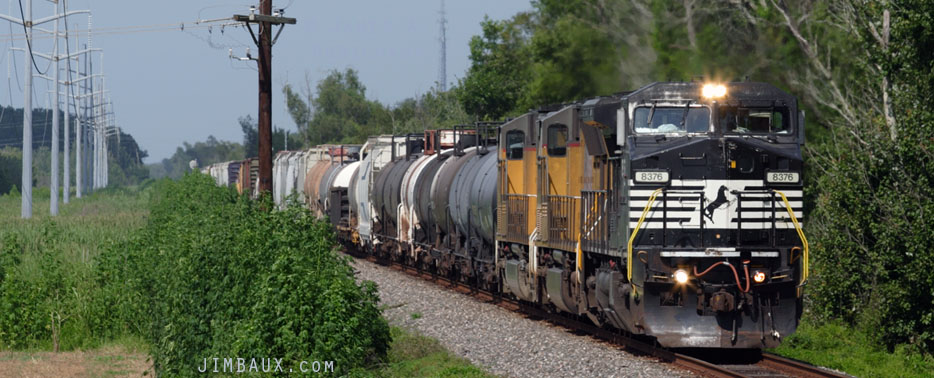
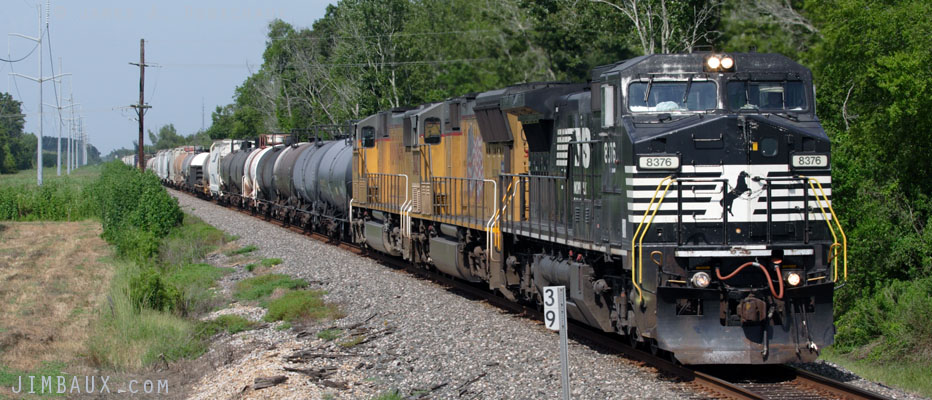

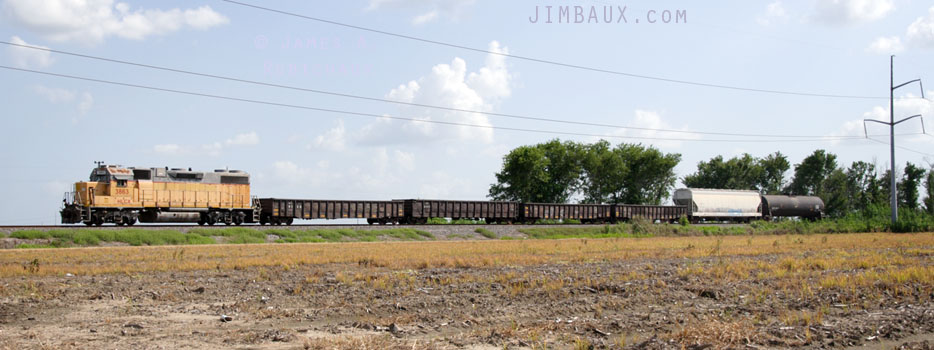
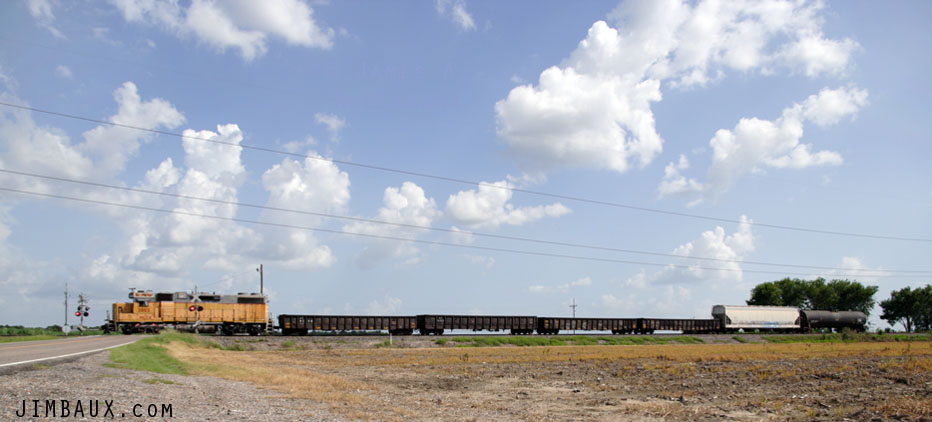
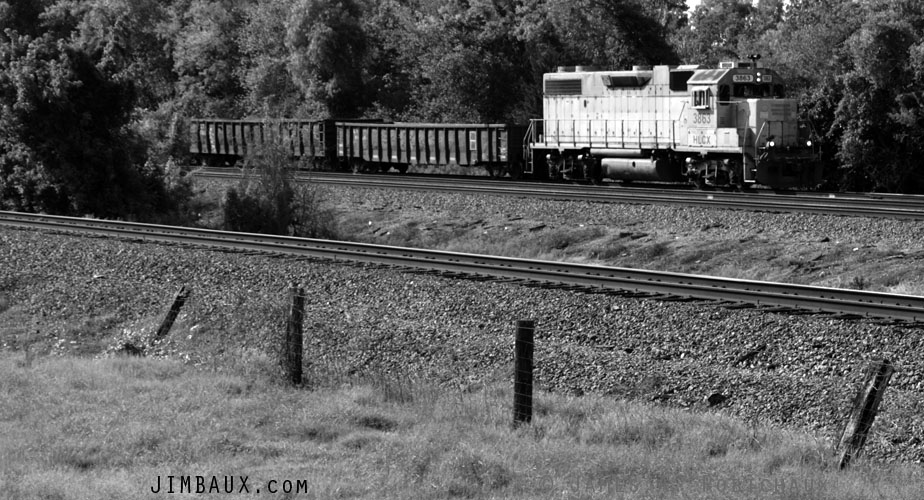
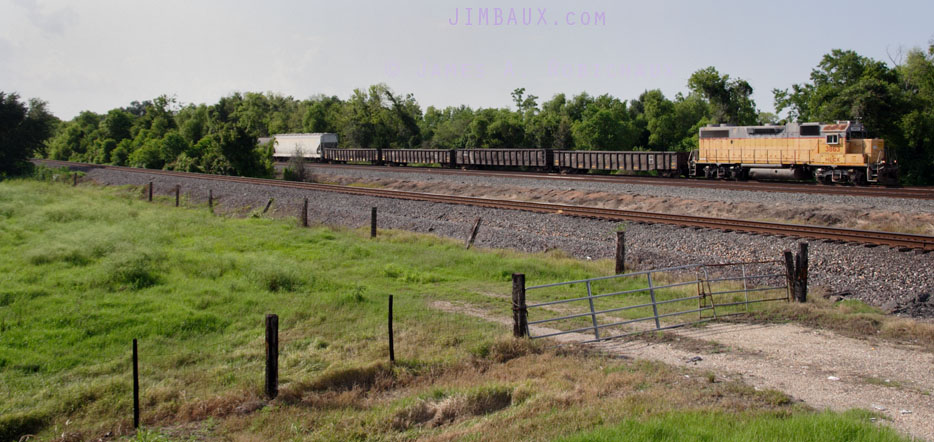
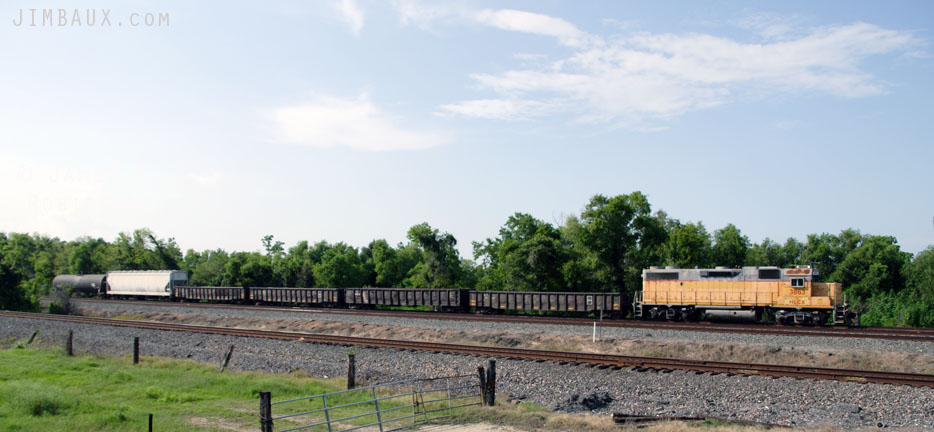
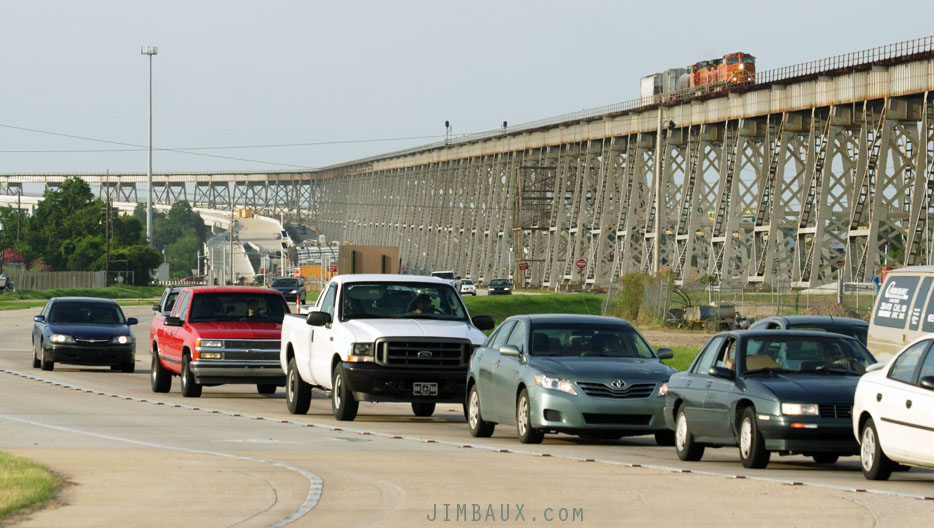


{ 7 comments… read them below or add one }
I like it, looks like you’re toying with a change, or perhaps expansion of your photography “style”. It’s working. Good stuff.
In pics #4 & 5, you can see the train because the sugar cane has been harvested. You usually get shots when the cane seems to be 6+ feet tall.
PPA, While what you said is indeed correct (well, not totally, since it seems that the cane field in the foreground wasn’t planted at all this year), and while what you mentioned is indeed definitely worthy of mention, it’s not really the answer I was seeking as to what elements, what placement of objects and absence of objects, and what positioning makes this shot so great. The fact that there was no cane in the fields merely allowed me to get low enough to create the effect that I was seeking. However, the answer to the inquiry is not something about the foreground. Anyone else care to guess?
Great job james, you and your camera is doing so well, specially with wide angle lens
Don’t let the rivet counters, etc, get the better of you on train symbols. I lived in NS territory for about 10 years. I swear they pick ’em out of a hat. By the way, that’s a former Conrail unit leading. You can tell by the low number boards and high headlight.
I’m going to guess that it’s the train silhouetted against the sky (mostly) – most of your pictures have a train, trees in the background and maybe a little sliver of sky at the top. The BNSF on the Huey P. Long in this post and the Crescent crossing Lake Pontchartrain shares the same feature, but I feel like those are in the minority (and both on bridges, which elevate the train and make the train on sky background easier).
Ryan essentially has the right answer, but I’ll have to take it just a step further to bring all of you to what I’m trying to get you to see. Think of it as Barry Sanders making a 70-yard run, and then “Touchdown” Tommy Vardell bringing it 1.5 more yards into the endzone!
Not only is most of the train silhouetted against the sky, but a particular part of it is that nobody has mentioned yet. See what I mean? Notice in picture 4 that the sky can be seen underneath the locomotive and the first gondola car. Isn’t that neat? I think so. Why? Well, partly because it’s very difficult to do. As Ryan said, most of my shots show trains set against trees (if not ballast.) In order to create the effect that you see in picture #4, the rails must be on the horizon. Creating such an effect is impossible in most places no matter how close to the tracks or how deep in a ditch the photographer gets. Obviously, standing on top of the truck would not have worked well here, but I had to go even further and almost lie down in the sugarcane field. Had I just stood upright, the trees in the far distance would have crept above the rails and spoiled the effect.
However, not only did I have to be at a certain height, but I also had to be a certain distance from the track. Here’s where geometry really helps us understand things. Had I gotten too far away, the trees in the far distance on the other side of the track would have been visible just above the rails, making the shot not nearly as cool. Conversely, had I gotten much closer to the track, the rails would still be on the horizon, but the optical axis from the camera-lens would have intersected with the plane of the top of the track and the underneath of the train at too obtuse of an angle, meaning that all we’d see between the rails and the train was the dark underbelly of the rolling stock.
I think that showing the sky not just above and on the sides of the train but underneath it as well really gives a sense of the essence of the rolling stock. It allows you to see where it is not! Thus, it gives you a sense of where and what it is, its essence. We will see in the next episode a set of similar shots from this location, but at least one of them with the sky not visible below the cars, making the effect not as cool, in my opinion.
I hope that this helps! This is one of the aspects of photography that I love about photography, how art meets science.
{ 4 trackbacks }